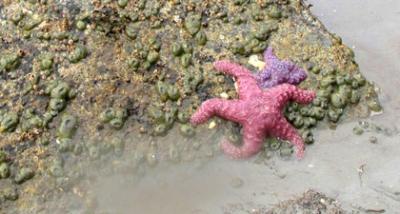
Oh No! The Tide Is Falling!

At Point Robinson on July 4 this year we’ll be celebrating both our nation’s independence and the splendors of our shoreline. From 10am to 3pm, there will be beach naturalists, booths with food and displays, lighthouse tours, a walk with Odin Lonning to learn traditional native uses of shoreline species, the landing of the Blue Heron Salish canoe, and other special activities. But the extra low tide of -3.1’ at about 11:50am will not be an occasion for merriment among the creatures who live along the shore’s edge!
Rachel Carson, in a 1937 essay called "Undersea," wrote "Who has known the ocean? Neither you nor I, with our earth-bound senses, know the foam and surge of the tide that beats over the crab hiding under the seaweed of his tide pool home…" But suppose we try to imagine the experience of low tide for a barnacle, sea star, and clam.
Perhaps as the sun rises and the tide retreats, it seems much like other summer mornings for the acorn barnacles attached to rocks on the upper beach. High tide during the night covered them with water, and they waved their fin-like cirri in the water to sieve particles of food from it. When the waves began to recede, they waved goodbye to their food transport system, tucked their cirri down into their little white calcium fortresses, and closed the hatches on top to seal in moisture and protect them from sunlight, crows, gulls, and other threats. Being up in the higher part of the beach, they are accustomed to waiting through dry spells every day, and can live for hours in air.
The receding tide exposes the middle beach zone by 10am, uncovering a purple sea star at the base of a boulder. Like the barnacles, the purple star had spent the night hours feasting under cold water. Perhaps it had wrapped an arm around a shield limpet on the boulder, and set its tube feet to work. With dozens of little tubes glued to the shell, it pulled the limpet upward until the limpet’s muscles finally gave out in exhaustion. Then the star everted its own stomach into the space between the limpet’s shell and the rock, secreted digestive juices into the shell, and enjoyed dining on fresh limpet sushi.
Now, feeling air replace the water, the purple star snuggles into the coldest, darkest, wettest cranny where the overhanging boulder shades the sand at its base. There a shallow puddle remains, filled with trailing rockweed and stray blades of sugar kelp. Nestled in its moist nook, the star waits for the returning tide. Above it on the rock, dozens of other beach animals now feel the harsh sunlight drying them off. To avoid death by dehydration, the thatched barnacles close their plates, the limpets clamp tight to the rock, and every dogwinkle and checkered periwinkle pulls its foot inside and seals its spiral shell to stone between patches of rockweed, trying to keep moisture in and air out, and hoping to discourage gulls and crows from prying it off its perch.
Diverging from its average cycles, the tide reaches its usual low tide zone and continues to recede, influenced by the gravitational forces of the sun and moon aligning on opposite sides of the earth (hence a full moon). As the water level falls to a -3’ it bares a zone of beach that very seldom feels air, and then only for minutes. Among the deep intertidal expanses of sugar wrack, sargassum, sea lettuce, and other seaweeds live whole communities of snails, crabs, nudibranchs, clams and other species that need water for survival. A geoduck living in the lower part of an eelgrass bed notices the sensation of air on its siphon. The siphon, which sometimes projects eight inches above the sand, is used to inhale water, from which the geoduck extracts food particles. Even exposed briefly at the super low tide, the geoduck itself stays moist deep in the wet sand, and may not bother to retract its siphon unless it’s poked by a gull or a finger. Around it, however, nudibranchs, anemones, and even small fish or octopus under the rocks may find the air dangerously warm and dehydrating. "Oh no!" they must be shrieking. "The tide is falling to crisis levels!" But fortunately, the tide will soon turn, and their temperatures can go down to a more comfortable range of frigidity.
So when you come to the Low Tide Celebration, look closely at the animals you see. They are not lounging around relaxing! Perhaps if you pay close attention, you will discern their slow motion struggle to survive the dangerous invasion of air and all the threats posed by air and air breathers like us!
- Login to post comments
